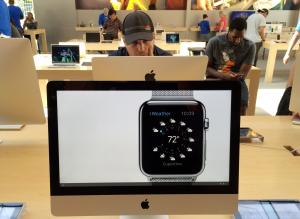Apple’s earnings vaulted by 27.5% for the first three months of 2015 compared to the same period last year, on the phenomenal Chinese sales driving profit margins for the iPhone 6. The virtuous smartphone tailwind and buzz about the Apple Watch spiked store traffic that also goosed Mac sales.
With an operating margin of over 30 percent and $194 billion in the bank, Apple deserves to be the world’s most valuable company.
Apple’s growth has been fueled by the continuing success of the iPhone 6 and the company’s rapid expansion in emerging markets, especially China.
Business schools teach that very big companies tend to suffer from the “law of large numbers,” where their growth percentage slows as they run out of new customers.
Apple has turned that law on its head for the last two quarters.
Wall Street analysts had been predicting $55.7 billion in revenue and unit sales of 55.8 million iPhones. Instead, the company booked $58.2 billion in revenue, powered by 61.2 million i-Phone sales.
As John Gruber commented: “five years ago Steve Jobs noted, with considerable pride, that Apple had become a $50 billion company in annual revenue. Today, they’re a $50 billion company in quarterly revenue, and are easily on pace to book $50 billion in annual profit this financial year.”
Apple reported $194 billion of cash in the bank, almost twice as much as Microsoft’s $107 billion, as the next largest non-financial company. After repurchasing $80 billion of its own stock, Apple increased the quarterly dividend to $0.52 per share, and funded an additional $140 billion stock repurchase program through March 2017.
Chief Executive Officer Tim Cook emphasized that Apple’s free cash came after the company quietly made 27 acquisitions in the past six quarters and undertook rapid retail expansion in China.
Apple now has 21 stores in China, and plans to double the number by the middle of next year. Compared to last year’s quarter, Chinese revenue was up 71 percent and contributed 58% of Apple’s growth in all emerging markets. Mac sales jumped by 31 percent. The online iOS App store had over 100% annual growth in China.
Given that Steve Jobs was actually a graphic designer who advocated for the user experience by purchasing innovative young companies, Apple was known for skimping on research and development compared to the rest of tech. Apple R&D amounted to only 3.31 percent of revenue versus 13.73 percent for Microsoft (MSFT), 15.90 percent for Intel (INTC) and 23.40 percent for Google (GOOG).
Apple CEO Cook acknowledged on the company’s analyst conference call that Apple needs to invest more internally to support the growth of “foundational technologies.”
Cook did not release any information about the Apple Watch sales, but highly respected analyst Mark Hibben, who did a teardown to identify vendors and source component costs, believes the product is in very limited supply: “The Apple Watch is probably more difficult and costly to assemble than an iPhone.” He believes “the gross margin for the Watch will be lower than the corporate average, not just the iPhone.”
Hibben added, “Given the supply constraint, it’s understandable that Apple chose not to release any Watch sales figures. Such figures would have been immediately seized upon as proof that the Watch is a flop.”
According to CEO Cook, what is fueling Apple iPhone sales in China is the rise of that country’s new middle class. Apple has positioned itself as an upscale fashion statement, and Apple’s retail stores present a sense of beauty and elegance that reinforces that perception, appealing to new Chinese consumers.

COMMENTS
Please let us know if you're having issues with commenting.